The Challenge
Due to a lack of maintenance, the hoist used to remove pumps at Southern Water’s Monxton site no longer met the HSE’s Lifting Operations and Lifting Equipment Regulations 1998 (LOLER) and was therefore unsafe for use. Southern Water needed a safe-to-use hoist before they could continue removing and replacing blocked wastewater pumps.
The Solution
The entire hoist, power supply and pendant control was replaced, as repairs would have been extensive, time-consuming and costly. Street Cranexpress delivered a complete solution from service to supply and installation, including the addition of a festoon system, an isolator and protective covers for the pendant and hoist.
The protective covers were proactive measures to slow down deterioration, ensuring the new equipment would remain in service for the duration of their respective design lifespans.
Weather-beaten
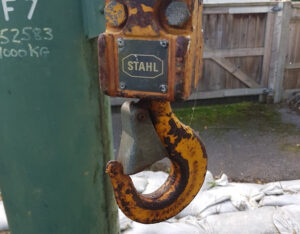
The weather-beaten, heavily corroded bottom block
- The hoist was in a highly corroded state.
- Corrosion is a natural process of deterioration, which is sped up by exposure to adverse weather; the process can be slowed by protection from the elements.
- When corrosion is found on any lifting equipment, the integrity of that part comes into question, and it can no longer be used.
Unsafe for use
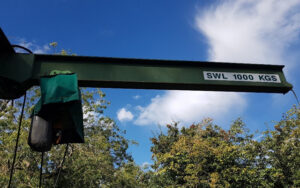
Original hoist, with no festoon system
- The power supply didn’t have a festoon system, so the cables hung dangerously low, looking untidy and causing a potential hazard.
- The pendant casing had become full of water, causing faults when operating.
- There was no isolator installed, so the electrical supply was not protected.
The hoist unit did not meet LOLER regulations
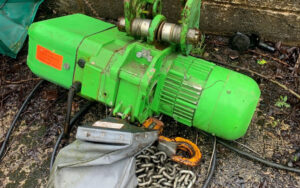
Original hoist, removed safely to ground level
- Having a festoon system installed allows the hoist to travel the full length of the beam, keeping the cable out of the way of the hoist.
- This reduces the risk of the cable becoming snagged on the load.
The importance of a festoon system
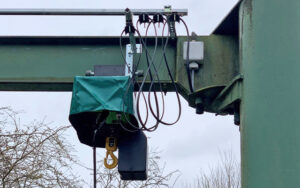
Newly installed track and festoon system
- Having a festoon system installed allows the hoist to travel the full length of the beam, keeping the cable out of the way of the hoist.
- This reduces the risk of the cable becoming snagged on the load.
- The addition of the new power supply and festoon system is not only practical, but also looks presentable.
Ensuring the electrical supply is protected

Newly installed local isolator
- Previously, the hoist did not include a local isolator.
- The jib crane was powered by a flying lead from the building located on site.
- Street Cranexpress installed a local isolator on the jib column, in accordance with BS 7671.
Replacing the unsafe hoist
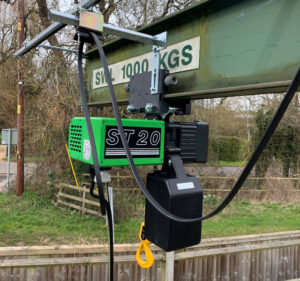
New hoist before it was fitted with a weather cover
- The existing hoist unit was disconnected from the electrical power supply, before being mechanically disconnected from the runway beam and lowered to floor level.
- A new hoist unit was supplied and installed by our skilled overhead crane engineers.
- A proof load test and a Report of Thorough Examination were produced once the new hoist had been installed.
Ensuring the new equipment is active for the duration of its lifespan
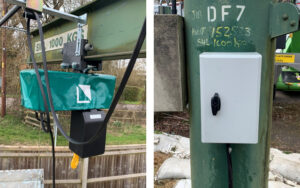
Protecting the new equipment
- To protect the new equipment installed by Street Cranexpress, a weather cover was provided to protect the hoist when not in use.
- A pendant box was also installed to protect the pendant control from the elements.
- Each piece of lifting equipment has its own design lifespan, and protection from the elements ensures the equipment remains in use for as long as possible.